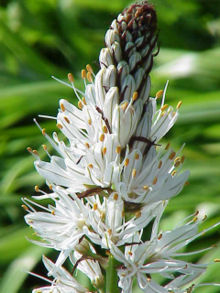Glyphosperma
| Asphodelus | |
|---|---|
 |
|
| White asphodel (Asphodelus albus) | |
| Scientific classification | |
| Kingdom: | Plantae |
| Clade: | Angiosperms |
| Clade: | Monocots |
| Order: | Asparagales |
| Family: | Asphodelaceae |
| Subfamily: | Asphodeloideae |
| Genus: |
Asphodelus L. |
| Synonyms | |
|
|
Asphodelus is a genus of mainly perennial plants first described for modern science in 1753. The genus is native to temperate Europe, the Mediterranean, Africa, the Middle East, and the Indian Subcontinent, and now naturalized in other places (New Zealand, Australia, Mexico, southwestern United States, etc.).
Asphodels are popular garden plants, which grow in well-drained soils with abundant natural light. Now placed in the family Asphodelaceae, the genus was formerly included in the lily family (Liliaceae).
The plants are hardy herbaceous perennials with narrow tufted radical leaves and an elongated stem bearing a handsome spike of white or yellow flowers. Asphodelus albus and A. fistulosus have white flowers and grow from 1½ to 2 ft. high; A. ramosus is a larger plant, the large white flowers of which have a reddish-brown line in the middle of each segment.
The leaves are used to wrap burrata, an Italian cheese. The leaves and the cheese last about the same time, three or four days, and thus fresh leaves are a sign of a fresh cheese, while dried out leaves indicate that the cheese is past its prime.
Women in Elizabethan Lancashire used it as a yellow hair dye.
In Greek legend the asphodel is one of the most famous of the plants connected with the dead and the underworld. Homer describes it as covering the great meadow (ἀσφόδελος λειμών), the haunt of the dead. It was planted on graves, and is often connected with Persephone, who appears crowned with a garland of asphodels. Its general connection with death is due no doubt to the greyish colour of its leaves and its yellowish flowers, which suggest the gloom of the underworld and the pallor of death. The roots were eaten by the poorer Greeks; hence such food was thought good enough for the shades. The asphodel was also supposed to be a remedy for poisonous snake-bites and a specific against sorcery; it was fatal to mice, but preserved pigs from disease. The Libyan nomads made their huts of asphodel stalks.
...
Wikipedia
